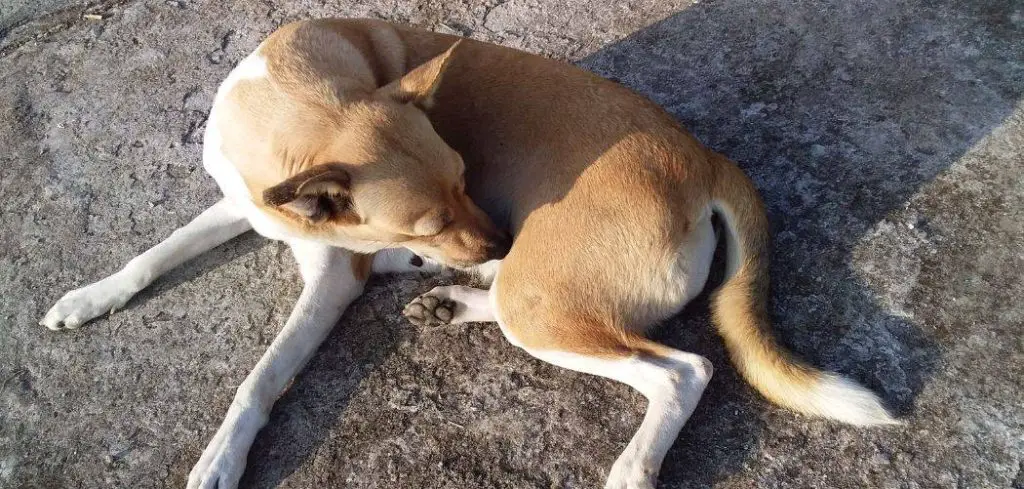Excessive grooming in dogs can be worrying for owners, especially when it leads to hair loss, irritated skin, or open sores. While occasional licking or chewing is normal, constant grooming often points to an underlying problem that needs attention.
We outline the common reasons for excessive grooming in dogs, what you can do at home, and when to seek veterinary help.
Table of Contents
Dog Excessively Grooming — Why It Happens
Excessive grooming in dogs usually happens because of skin irritation, allergies, parasites, stress, or underlying pain. Dogs may lick, chew, or bite at their fur as a way to soothe discomfort or relieve anxiety.
While it may seem like a harmless habit, constant grooming can damage the skin, worsen the underlying issue, and even cause infections if left untreated.

Dog Excessively Grooming: Common Causes
Allergies
Allergies are one of the most common reasons for excessive grooming in dogs. Food sensitivities, environmental allergens like pollen or dust, or contact reactions from chemicals can trigger itching.
When the skin feels irritated, dogs instinctively lick and chew the area for relief. Over time, this can create hot spots, fur loss, or redness.
Allergies often cause seasonal flare-ups but may persist year-round in sensitive dogs.
Read more: Dog Excessively Biting Tail (When to worry)
Fleas and Parasites
Even a few fleas can cause intense itching, leading to obsessive grooming. Dogs often lick or chew around the base of the tail, belly, or legs where fleas tend to gather.
Mites or lice can have a similar effect, leaving dogs restless and unable to stop grooming themselves.
Because parasites feed on your dog’s skin or blood, the irritation can quickly escalate into raw patches or open wounds.
Skin Infections
Yeast and bacterial infections often make dogs excessively groom specific spots. A dog may keep licking a paw, ear, or belly where an infection has developed.
Moisture trapped in the skin folds or between the toes can create the perfect environment for infection, which then drives more grooming. A distinct odor, redness, or oozing can be signs of an infection that needs treatment.
Anxiety or Stress
Excessive grooming is not always caused by physical irritation — sometimes it’s behavioral. Dogs under stress or dealing with separation anxiety may develop compulsive grooming habits.
Like nail-biting in humans, the repetitive licking and chewing can become self-soothing, even when the skin is not irritated.
Unfortunately, this habit can turn into a cycle where the grooming itself causes wounds that worsen the behavior.
Pain or Arthritis
Sometimes, dogs groom excessively because they are trying to ease discomfort from pain. Joint pain from arthritis, injuries, or muscle soreness can cause a dog to repeatedly lick one spot.
This type of grooming usually focuses on a single area, such as a hip, knee, or paw. Owners often mistake it for itching when it’s actually a pain response. Identifying pain-related grooming is crucial, especially in older dogs.
Hormonal Imbalances
Endocrine problems like hypothyroidism or Cushing’s disease can change the condition of your dog’s skin and coat. Hair loss, dryness, or thinning skin may prompt your dog to lick and chew excessively.
Because these conditions affect the body as a whole, dogs with hormonal imbalances may groom multiple areas rather than focusing on one spot. Left untreated, the skin damage can become severe.
What to Do If Your Dog Is Excessively Grooming
If your dog is grooming excessively but otherwise acting normal, start with a careful inspection. Look for fleas, redness, bumps, or wounds that might explain the behavior. A flea comb and close check under the fur can help you catch the signs early.
Improving skin and coat health often helps reduce the urge to groom. Omega-3 fatty acids, a high-quality diet, and regular bathing with gentle, vet-approved shampoos can soothe irritation.
If stress seems to be a factor, providing mental stimulation and consistent routines can ease anxiety. Puzzle toys, extra playtime, and safe spaces for rest all support calmer behavior.
For dogs eating the same food long-term, a dietary trial under your vet’s guidance may rule out allergies. Switching to a limited-ingredient or hypoallergenic diet sometimes makes a noticeable difference.
In the meantime, protective tools like Elizabethan collars or soft recovery cones can prevent self-inflicted wounds while you address the underlying cause.
When to Call or Visit Your Vet
Some cases of excessive grooming can be managed at home, but others require veterinary care. If your dog’s grooming is leading to bald spots, raw skin, or bleeding, it’s time for professional help.
Persistent licking of one spot can indicate pain, infection, or even a deeper medical issue. Dogs that won’t stop grooming despite interventions need a full checkup to identify the root cause.
If you notice signs like swelling, a strong odor, fever, or lethargy alongside the grooming, these may point to a serious infection or systemic illness. Don’t wait — seek veterinary care right away.
Even if the problem seems minor, ongoing excessive grooming should never be ignored. Left untreated, it can spiral into chronic skin problems and long-term discomfort for your dog.
Read more: Dog Excessively Licking Bed (What it could mean)
Key Takeaway
Excessive grooming in dogs may look like a simple habit, but it often signals something deeper — from allergies and parasites to infections, stress, or pain.
While some cases can be eased at home with diet improvements, parasite control, or stress management, persistent grooming needs veterinary attention.
By paying close attention to your dog’s habits and acting early, you can prevent skin damage, stop discomfort, and get your pet back to feeling comfortable again. Trust your instincts as an owner — if the grooming seems abnormal or is causing harm, don’t wait to get professional help.
